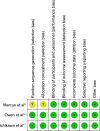Aripiprazole in acute treatment of children and adolescents with autism spectrum disorder: a systematic review and meta-analysis
- PMID: 30519027
- PMCID: PMC6237245
- DOI: 10.2147/NDT.S174622
Aripiprazole in acute treatment of children and adolescents with autism spectrum disorder: a systematic review and meta-analysis
Abstract
Background: Recent randomized controlled trials indicated that aripiprazole was the effective treatment for children and adolescents with autism spectrum disorder (ASD).
Objective: This study systematically reviewed the efficacy, acceptability and tolerability of aripiprazole in treatment of ASD children and adolescents.
Data sources: Electronic search of databases including, Scopus, PubMed, CINAHL and Cochrane Controlled Trials Register was performed in July 2017.
Methods: The full-text versions of included trials were meticulously evaluated and extracted. The main efficacious outcomes consisted of pooled mean change scores of the standardized rating scales for ASD and the pooled response rate.
Results: A total of 408 randomized patients from eligible trials were included for synthesizing in this meta-analysis. The pooled mean change scores in aripiprazole-treated group for the Aberrant Behavior Checklist (ABC)-Irritability, ABC-Hyperactivity/noncompliance, ABC-Inappropriate speech and ABC-Stereotypic behavior were significantly greater than those of the placebo-treated group. Unfortunately, the significant difference between two groups was not found for ABC-Lethargy/social withdrawal. The overall pooled response rate of the aripiprazole-treated group was significantly higher than that of the placebo-treated group. The pooled overall discontinuation rate in aripiprazole-treated group was significantly better than that of placebo-treated group. The pooled discontinuation rates due to adverse events in aripiprazole-treated group significantly differed from the placebo-treated group (RR [95% CI] of 1.43 [0.65, 3.18], I 2=0%).
Limitation: A small number of studies were gathered in this review.
Conclusion: Aripiprazole has efficacy in the treatment of behavioral disturbances, including irritability, hyperactivity/noncompliance, inappropriate speech and stereotypic behavior found in ASD children and adolescents; however, it could not improve the lethargy/social withdrawal in such patients. The present evidence also indicates that it is safe, acceptable and tolerable in such treatment. As a small sample size, further well-defined and large sample size studies should be conducted to warrant those findings.
Keywords: ABC; Aberrant Behavior Checklist; CY-BOCS; Children’s Yale-Brown Obsessive Compulsive Scale; acceptability; efficacy; tolerability.
Conflict of interest statement
Disclosure NM received travel reimbursement from Lundbeck and Pfizer. BM received honoraria and/or travel reimbursement from Lundbeck, Pfizer and Servier. SS received honoraria from Thai-Otsuka and Janssen-Cilag. MS received honoraria from Sumitomo Dainippon Pharma and Lundbeck. NM and BM are husband and wife. The other authors report no conflicts of interest in this work.
Figures












References
-
- Schreibman L. Intensive behavioral/psychoeducational treatments for autism: research needs and future directions. J Autism Dev Disord. 2000;30(5):373–378. - PubMed
-
- Spreckley M, Boyd R. Efficacy of applied behavioral intervention in preschool children with autism for improving cognitive, language, and adaptive behavior: a systematic review and meta-analysis. J Pediatr. 2009;154(3):338–344. - PubMed
-
- Béhérec L, Quilici G, Rosier A, Gerardin P, Campion D, Guillin O. Pharmacological treatments in patients with pervasive developmental disorders: A review. Encephale. 2014;40(2):188–196. - PubMed
LinkOut - more resources
Full Text Sources
Other Literature Sources
Research Materials

